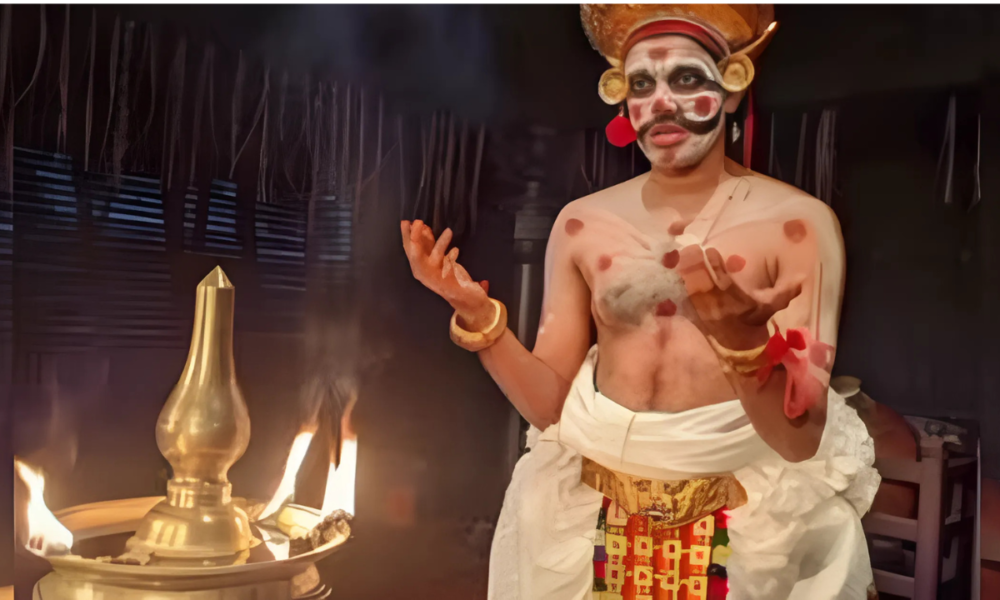Chakyar Koothu is a type of classical art form, which belongs to the mainstream acting culture evolved in 17th century South India. It is a kind of mono act. It is the analogue of an old fashioned comic act. The only difference is that in contrast to stand-up comics, the performer has even more of a license as he or she can heckle back at any point.
This is a classical dance that will be performed only by the person from professional Chakyar group and that too in Koothambalam of temples. This is one of the oldest forms of theatre arts specific to Kerala. The word Koothu or dance, which is the index of the importance that was paid to it in antiquity as well. Infact, the bodily movements as well as facial expressions and gestures made by actor in Koothu are reportedly correspond to almost exactly with those stated in Bharatha’s Natya Sastra which i defined authoritative Sanskrit treatise on this discipline.
The process becomes an image of the ritual performance in which actor as performer recites stories e.g. from one or other epics (Sanskrit text tradition) translating it into Malayalam and animating his delivery with Thandava dance rhythm, gestures & bodily postures that have been derived clearly enough from Natya Sastra.
Koothu, the ceremonial dance associated with these temples -a misnomer as it is not really a danced form,though vital facial expressions are used. It is otherwise traditionally done in a Hindu temple and the performer worships first at the deity of that specific temple. He then starts narrating a verse in Sanskrit and later on explains it in Malayalam, one of the local languages. What follows in narration is light hearted reflection on current events and social commentary done with wit, sass & charm;
More than anything, The Koothu is all about THE comic element. Almost dramatic in character, the narrative art of Chakyar gets imitated through mime/gesture interspersed occasionally with dances. The narration is done with much of humorous, witty analogies laced with references to contemporary political and social events; dancer gets does get enough chances for a thorough assessment local men and things Rarely will the miss to take pot shots at life […] He savages the follies and foibles of the age with utter disregard for their feelings.
The dancer stands at the performance area of the koothambalam, dressed in his distinctive headgear and elaborate make-up. He then prays to presiding deity of that temple wherein he is performing. Then he reads out a verse from the original Sanskrit text, which is to be expanded in details by him one after another during recitation and explanation in Malayalam. The instruments played are a pair of Cymbals and the mizhavu which is an imposing big copper drum. Beating rhythm on the Mizhavu at required intervals i. circ.: a member of Nambiar caste<()> Nangiyars, who are women moreover always superimpose the cymbals. If a Chakyar presents Koothu asa solo item, it is known by the name Prabhandha koothu. Seldom is it presented by a Nangiyar woman, then known as Nangiyar Koothu.
The Chakyar community used to perform the koothu. Nangyarammas from Nambiar caste, perform the part of Koodiyattam which is exclusively for lady charecters this being called as Nangyar koothu and has no relation with Chakyar Koothu. Accompanying the performance are just two instruments- a mizhav and kappu in:return sandai.
According to this, Chakyar Koothu was performed in Koothambalams of Hindu temples only but it has been Guru Natyacharya Vidushakaratnam Padma Shree Mani Madhava Chakyar vision who was the greatest koothu and kudiyattam artist had brought out Kuthhu and Kudiyyat outside temple by performing for all people. Ans: He is known as the greatest Koothu and Kutiyattam artist of our times.
During that time when Mani Madhava Chakyar’s guru, His Highness Darsanakalanidhi Rama Varma Parikshith Thampuran wrote a brand new Sanskrit champu prabandha called Prahladacharita and asked some senior artists to learn it & present on the Chakyarkooth stage, they said impossible for them as this sent great confidence among people like Koodalmanikkam Elanglammani Namboodiri (Sreepadam school native of Thrissur). That was when the guru turned to a much younger artiste, Mani Madhava Chakyar. He was in agreement and so he learned a portion of the prabandha from him overnight, then sang it for the very first time on stage at Tripunithura — what used to be Kochi state’s capital! This unfolding made many great pandits to accept his flourished command over both Sanskrit and the classic arts. He did full performance of Prahla-dacharita on the same stage after some months.

